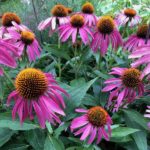
Blessings at the new moon – April 30 2022
This permaculture new-moon post is part of my lunar blog post series. To learn more about this series and read past articles click here.
My Permaculture Experience
I completed a permaculture design course many moons ago with Dancing Green Permaculture in Pennsylvania. Looking back, I realize I did not completely grasp the bigger picture of systems theory and design. My interest was on learning all the cool techniques like keyhole gardens and hügelkultur. And while those concepts are great in the right time and place, they are simply tools to be used when appropriate.

Permaculture is so much more than a set of techniques. It is a way to view the world. Noticing systems and connectedness are integral to permaculture. We begin by first observing the environment and then enhancing existing connections or making new ones. Ultimately the goal is strengthening a system for optimal results. That system can be a landscape, a home, community, or entire culture. Optimal results can be everything from a sustainable food supply to healthy, just, and equitable communities.
Permaculture as Mindful Practice
Mindful observation is at the heart of permaculture. This occurred to me long after I had completed my course. It is not simply an extension of organic gardening, as I thought at the beginning. Organic gardening has a set of techniques that can be applied to growing healthy food. Permaculture design might even use those organic gardening techniques. However, permaculture begins by intentionally looking for patterns and relationships. From there a design is created that enhances what already exists.

In an urban landscape it might mean paying attention to the areas of sun and shade and taking advantage of areas that warm up sooner in the spring and stay warmer in the fall. Another example is taking note of the wild plants growing in a landscape (weeds) and what they tell us about soil health and structure. And making use of existing resources like using leaves for mulch or collecting water in rain barrels are other examples. But it is intentional observation and then design as a second step that is important.
Working with Permaculture Concepts
Mindful attention and observation are applicable to all of our endeavors. Although permaculture began with a focus on sustainable food production, the ethics and principles can be applied across all human endeavors. In another part of my life, when I am not in the garden, I am a trainer and curriculum developer. Training very much involves observing the flow of energy in the room, how connections and interactions are developing, and finding ways to enhance those. Three permaculture princples I embrace in my work as a trainer are:
- observe and interact
- apply self regulation and accept feedback
- creatively use and respond to change.
 And these principles can obviously be applied to all human interactions with positive results.
And these principles can obviously be applied to all human interactions with positive results.
In honor of International Permaculture Day tomorrow (May 1st) I’d like to suggest honing your observational skills between now and the full moon. If you accept the quest, some questions to consider in contemplation or journaling include:
- What patterns are you noticing in your home, landscape, and human connections?
- How are all the different elements interacting?
- Which of these connections are supportive and which cause some challenges?
It can be fun to consider these first three questions with poster board and markers. Take some time to visualize and map out the connections and interactions on paper. This may provide more insight than simply thinking about the questions.
And then a final question:
- How can you – with creativity – enhance positive connections and manage challenging ones? We ask this question knowing that systems will grow and change and we’ll need to return to all of these questions again and again. And that is simply the nature of life on the planet.

For more information and resources on permaculture click here.



“Mindful observation is at the heart of permaculture” – love this sentence! It’s so true <3 Care for people; Care for nature; Recycle surplus//fair share, take care of physical objects such as food and garden, vegetarian/vegan meals, grey water treatment, gift economy. Those are all things we need!
Permaculture is a beautiful philosophy that provides a map forward for all of us! Thanks for your comment!